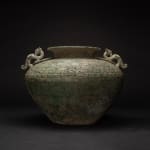Eastern Zhou Warring States Bronze Vessel, 400 BCE - 250 BCE
45.7 x 33 cm
18 x 13 in
18 x 13 in
HK.5081
Further images
-
(View a larger image of thumbnail 1
)

-
(View a larger image of thumbnail 2
)

-
(View a larger image of thumbnail 3
)

-
(View a larger image of thumbnail 4
)

-
(View a larger image of thumbnail 5
)

-
(View a larger image of thumbnail 6
)

-
(View a larger image of thumbnail 7
)

-
(View a larger image of thumbnail 8
)

-
(View a larger image of thumbnail 9
)

-
(View a larger image of thumbnail 10
)

-
(View a larger image of thumbnail 11
)

-
(View a larger image of thumbnail 12
)

Whereas before, war was characterized as a civilized contest between aristocratic armies, during the Warring States Period (475-221 B.C.), war evolved into the chaotic conflict we know it as today....
Whereas before, war was characterized as a civilized contest between aristocratic armies, during the Warring States Period (475-221 B.C.), war evolved into the chaotic conflict we know it as today. Kings and princes were replaced on the battlefield by infantries led by military generals. Peasants were recruited to serve on the front lines. Warfare intensified, especially in terms of the duration of campaigns. New arms and armor were invented, including the halberd and crossbow. Chariots rode alongside archers outfitted in iron helmets and body armor. Defensive walls were erected in order to repel invaders. However, despite the turmoil of the times, the arts continued to thrive. Bronze casting was revolutionized by the introduction of the lost- wax technique, allowing the production of more complex patterns and adornments.
Although the Warring States Period was marked by almost constant upheaval, it also represents a golden age of Chinese culture and thought. Needless to say, the arts continued to flourish as this exquisite bronze vessel reveals. Adorned with distinctive bronze age Chinese auspicious patterns, such a vessel may have been used to store foodstuff or wine. The smooth and even design is a testament to the technological advancement in pottery for which the period is renowned. Moreover, beginning at the vessel's widest cross-section and continuing up towards the raised lip, subtle impressions rendered in pairs of parallel lines adorn the upper half of the vessel. Like its earthen predecessors, however, the lower third of the vessel has been left unadorned and unglazed. And as such, the lower third may have also been partially buried for stability in storage, as typical of earlier cultures like the Yangshao. Stemming from between the decorative impressions, two handles protrude from opposite sides depicting zoomorphic motifs, perhaps a ram or taotie with ram-like horns so common to the time - both auspicious symbols in Warring States China.
Pair with HK.5095
Although the Warring States Period was marked by almost constant upheaval, it also represents a golden age of Chinese culture and thought. Needless to say, the arts continued to flourish as this exquisite bronze vessel reveals. Adorned with distinctive bronze age Chinese auspicious patterns, such a vessel may have been used to store foodstuff or wine. The smooth and even design is a testament to the technological advancement in pottery for which the period is renowned. Moreover, beginning at the vessel's widest cross-section and continuing up towards the raised lip, subtle impressions rendered in pairs of parallel lines adorn the upper half of the vessel. Like its earthen predecessors, however, the lower third of the vessel has been left unadorned and unglazed. And as such, the lower third may have also been partially buried for stability in storage, as typical of earlier cultures like the Yangshao. Stemming from between the decorative impressions, two handles protrude from opposite sides depicting zoomorphic motifs, perhaps a ram or taotie with ram-like horns so common to the time - both auspicious symbols in Warring States China.
Pair with HK.5095











